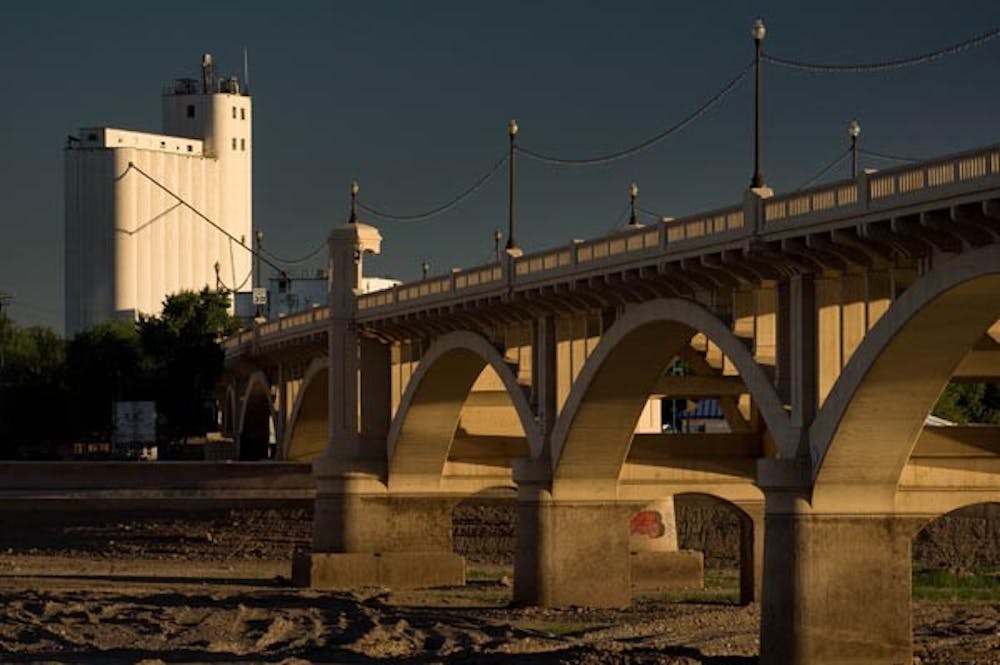A stack of papers and binders litters the desk of Tempe’s Community Development Director Chris Anaradian.
“This is my pile of broken dreams,” Anaradian said.
The files are discarded plans and blueprints for what was a major redevelopment of Tempe’s downtown area.
The recession put a stop to major redevelopment projects for downtown Tempe. For now, the future of many of these projects remains uncertain.
The city’s Community Development Department has been forced to work even harder to encourage development in and around Mill Avenue.
Three years ago, Tempe found itself in an average economy, neither a boom nor a bust. In 2004 and 2005, the city would have likely seen 10 to 12 different residential projects in motion, with generally 20 retail commercial projects coming through at different stages, Anaradian said. Those numbers have since dropped significantly.
“People in Tempe are getting tired of hearing about Mill Avenue and the lake, but [the downtown area] is our economic engine,” said city councilwoman Onnie Shekerjian, a member of the city’s economic and community development committee. “It is something we should be treating like our community living room.”
The economy started to tank at the very same time that the downtown community was going through large-scale redevelopment, she said.
“Redevelopment like this happens about once every 20 years, and that is what we were seeing,” Shekerjian said.
The majority of Mill Avenue is privately owned by three landowners: DMB, a development firm out of Scottsdale that owns about half of Mill Avenue, Holualoa, a company based out of Hawaii, and ASU, which owns several private entities on the street.
This land ownership is based on investment trusts that came in during the 1970s and ’80s that bought land, Anaradian said.
Vacant spots on Mill Avenue are directly related to economic development problems. In 2006, DMB planned to tear down all the buildings on the land they owned and rebuild an eight-story structure with a hotel. The movie theater was shut down in preparation for new expansion, but when plans were put on hold, the Downtown Tempe Community intervened and asked DMB to host MADCAP as a placeholder to keep business bustling.
The community took the abandoned movie theatre space and with simple renovations, converted six theatres to host a variety of performances and activities.
“This is what happens when you are a landlord with all these tenants and shops,” Anaradian said. “They kicked them all out and wouldn’t renew their lease.”
There has never been a shortage of interested business owners, Anaradian said. All development plans were put on hold because of the recession and doing so affected all the future business owners.
A major project that was put on hold in 2008 was development of the Hayden Flour Mill site on Mill Avenue.
Plans included transforming the old building into boutique retail and office space, as well as a small hotel. The mill was to be preserved and incorporated into a modern composition of glass and steel.
Contracting corporation Avenue Communities partnered with Tempe to lead the second attempt of construction on the historical site.
Another developing company purchased the property in 1999 but defaulted on its payments. When the city bought back the property, a lawsuit ensued over the city’s right to own the land, but was eventually settled.
Anaradian recently addressed the city council about whether or not Avenue Communities would receive an extension on development plans.
“We have not been in contact with them for nine months,” he said. “It has been a very long and painful recession, so when things are going south people might avoid each other for a little while.”
The whole idea of admitting a project is dead is a new concept, Anaradian said. The original Hayden Mill deal was based on years of fighting and was eventually phased out.
This is the second phase of development that the flour mill has been involved with, and it is currently facing the same fate as the first stage.
“I really do believe that we can do this a third time and get it right, but the second attempt isn’t over yet,” Anaradian said.
Even with the bad economy Mill Avenue district has never had a drop in foot traffic or interest in businesses, said Casaundra Brown, marketing director for Downtown Tempe Community.
Retail sales revenue is up 3 percent based on the last report in July, Brown said.
Reach the reporter at amoswalt@asu.edu





